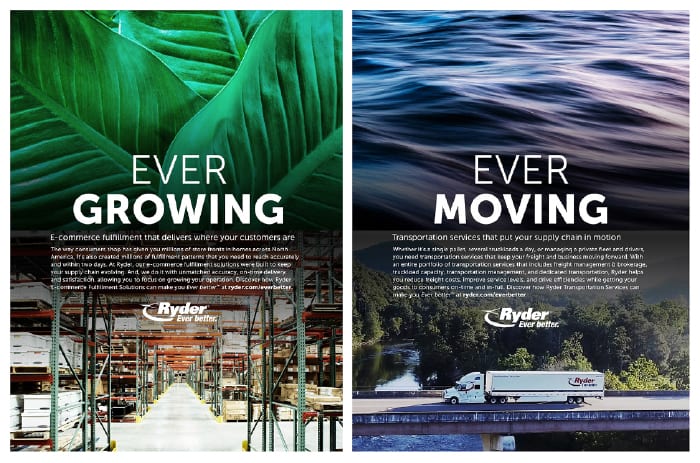
[Editor’s Note: Many companies say they listen to their customers, but how many do? And do they act on what they’ve heard? In an interview, Ryder CMO and EVP Karen Jones told us the idea that led to a marketing effort debuting this month, Ever Better World of Logistics, came directly from the mouths of customers.]

CMO and EVP Ryder
PRNEWS: First, are you in your offices?
Karen Jones: We’re not in our corporate offices. Ryder’s [non-corporate employees are] considered essential, so we have 800 facilities throughout the US [where 30K frontline employees are working]. We’ve done all the proper [coronavirus] protocols.
PRN: OK. Ryder hasn’t done a campaign this size since 2014. Why launch Ever Better World of Logistics in the middle of a pandemic and an historic economic downturn?
Jones: We planned it in 2019, partly around our growth strategy for our supply chain and dedicated business.
People know Ryder, they know us for our rental trucks and leasing business. Trucks are about $5 billion of a $9-billion business. But the other $4 billion is the supply chain and logistics products and services.
People don’t really know that we’re in this business. There is an awareness issue, because trucks overshadow the logistics and supply chain side of the business.
PRN: How did you come up with the idea?
Jones: The genesis of it came from our Customer Advisory Boards, where we invite about 20 customers twice a year to participate. We show them products and capabilities, talk about our offerings and what’s important to them, how they’re navigating their business. The resounding comment we got over the years was, ‘You have a best-kept secret. We had no idea you did all these other things.’ Maybe they thought of endpoint solutions.
Fast-forward to a time when we wanted to grow our business strategically, and we said, ‘Supply chain is really poised for growth opportunity’ mostly because of the rise of e-commerce. [Note: E-commerce has exploded in the US during the pandemic, according to McKinsey.] This was just prior to the rise of COVID-19.
I thought it was time for us to come out and share [our other products] with the world…and make sure the awareness level is high.
We planned to do the campaign in the beginning of the year and then we all got shut down [by the pandemic]. The strange thing is that COVID-19 accelerated [the topic of supply chains].
So, I call it ‘The Perfect Storm,’ because [COVID-19] is a storm, make no mistake, nobody wants it. But we were prepared to start touting our e-commerce capability and our supply chain and logistics business.
So, [the pandemic] makes this campaign more relevant. We laughed because we said consumers didn’t know what a supply chain was and now [because of the coronavirus] it’s a household word. Not that consumers are our target. It’s aimed at business-to-business decision makers who make choices on their supply chain logistics capability.

PRN: Tell us more about the Customer Advisory Boards.
Jones: Those boards are like a big research group for us, with B2B customers–everything from Fortune 50 down to 500, a lot of VPs, EVPs of supply chains¬–across the entire business. They come in for two days. This gives us a chance to hear what’s keeping them up at night and put new products and product ideas and services in front of them. They do a taste test for us. More importantly, we hear what’s going on in their world. We figure if those 20 customers are experiencing something, probably the rest of our thousands of customers are going through the same thing. All our senior executives participate in it as well as our CEO. We really want to know what our customers are thinking.
PRN: How long has Ryder been doing Customer Advisory Boards?
Jones: We’ve done these for about six years. The attendees love it. We bring them in on a Wednesday night. They have a full-day of meetings on Thursday and a half day on Friday. They craft the agenda; it’s member-led. We do pre-interviews with them to find out their issues, what’s working, what’s not. In addition, we bring in subject-matter experts to speak, and we also do peer-to-peer exchange.
It’s like therapy. They’re talking to people with the same problems. For us, it’s great because we get to hear what they’re thinking.
PRN: As a result of the pandemic, supply chains and logistics are part of the zeitgeist. But how do you make them sexy and reduce them to a 60-second TV ad?
Jones: [Deadpan] Very carefully. [Laughter]
PRNEWS: [Laughter]
Jones: It’s difficult. Remember, we’re advertising to people hopefully who are in the industry, so it’s not as difficult.
Our challenge was more insuring they understood the portfolio of products. This is an awareness campaign, but also a lead generation campaign.
At the TV level, though, it was more about the rallying cry from our customers who said, ‘You gotta tell more people that you do all this stuff.’ So, it’s really about telegraphing our solutions.
PRNEWS: Did you test the message?
Jones: Yes. The feedback was useful. It led us to change the script a little bit to make things clearer. As a communicator you’re always wondering, ‘Am I being effective with what I’m communicating?’
PRNEWS: Pull back the curtain a bit. You did this campaign entirely in house. Did you do it all during the pandemic?
Jones:Yes, we filmed this during COVID-19, with much of the filming at our facilities. We had really strict guidelines…about distancing, etc. It created an extra level of complexity.
PRNEWS: Tell us about why you did this in-house.
Jones: In the past, we’ve used agencies and we had success with some of them. But, over the past 2 years we’ve built a talented communication team that does internal and external, almost like an in-house agency.
We decided if we want to do this quickly, we realized we didn’t have a lot of time to re-educate an agency. So, for us, it was cost effective and we controlled the situation. I felt my team was able to handle it because they know the business so well.
PRNEWS: What did you learn?
Jones: We had to do all this virtually, drafting the scripts, getting approvals, work with Sony. We did all this on Microsoft Teams. We learned ‘If there’s a will, there’s a way.’ We leveraged every ounce of [Microsoft] Teams.
We learned it’s important to have great customers who will stand up and be part of your campaign and allow you to film at their facility.
And the research [was a lesson], making sure your message resonates in a customer environment. As communicators, we know we should [test messages], but sometimes we feel we should draft them and send them out there.
So, it was a great reminder [of a best practice] when we tested our messages [before releasing them publicly], including exposing them to people who really didn’t know us.
PRNEWS: What metrics are you using to measure success with this campaign?
Jones: I have two metrics. One is awareness. On television, we are testing a control group and an exposed group to see if brand awareness resonated. We do that mid-way through the campaign and at the end of the campaign.
Then, we also have a ‘show me the money,’ a lead generation [metric]. We have come up with a specific number on leads generated from this campaign. We track that weekly with a sophisticated program with Salesforce.
We know exactly where leads are coming from. With our business, it’s a long sales cycle. So, nine months to a year from now I may get an actual sale. So, in the short term, it’s all about the lead, the opportunity, the size of the opportunity and the beginning of getting a customer back to pitch them and hopefully get a sale. We set up a few different metrics.
CONTACT: afederman@ryder.com
